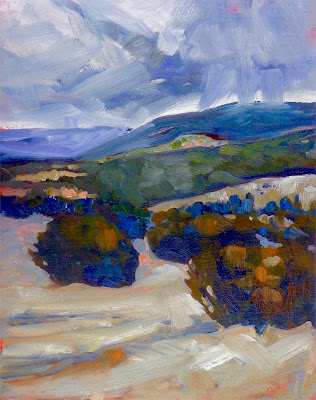A day painting a mural with kids reminds me of how precious friendship is.
 |
| Joe Anna Arnett painting with two girls in Pecos, NM. |
Jane Chapin bought a beautiful but worn adobe building in Pecos last winter. Her goal is to create a new Art Center for the town. This will be a place where kids can get more art education than they do in school. The art center will also be a base for adult painting workshops.
Regular readers may remember Jane as the organizer of our trip to Argentina in March. She’d planned to paint a mural with schoolkids in Buenos Aires at the end of that trip. They would work from artwork done by the Pecos kids. In return, she’d bring back artwork from Argentina that would become a mural in Pecos. This cross-cultural effort collapsed with the world shutdown from COVID-19.
 |
| My students pitched in too. Here’s Jeannie Cole working with a young lady named Mariah. (Photo courtesy of Linda DeLorey.) |
Normally, art centers take a percentage of tuition as their fee from instructors. As Jane sketched it out, the new art center would work differently. We teachers would teach our workshop and then do a project with the local kids as our contribution. I don’t often teach kids, but I like them just fine. I was looking forward to working with them.
Then COVID-19 hit, and the whole world ground to a halt. The county dragged out the process of issuing permits. Building renovations are still only half finished.
New Mexico imposed draconian limitations on visitors, so that hotels and B&Bs were essentially closed. My workshop only happened by the grace of God and the graciousness of Jane and her husband, who moved the whole operation to their home in the mountains above town.
 |
| Jane and a few of her minions. |
As of last week, the Pecos school district was doing remote learning only. This is absurd: to date, all of San Miguel County has had 103 cases and no deaths from COVID. This is a remote, rural, poor community, with some 30,000 people spread out over 4700 square miles of mountainous terrain. That means lousy or non-existent internet and cell-phone service. And it means extended isolation for these kids, who haven’t been in school since the end of March.
Jane gamely changed the mural project so she could salvage something for these kids. Instead of an exchange with Buenos Aires, she would have the Pecos kids paint their own images on the walls of the Pecos Art Center. She transcribed the drawings to the walls, and worried that nobody would show up.
But they did, and both kids and parents were enthusiastic. There were enough volunteers, including artists Joe Anna Arnett, Lisa Flynn, Gail Ewing, and two of my students, Jeannie Cole and Linda DeLorey. We were able to work very closely with the kids, and most of the mural got painted. It’s lovely, a sign of promise and hope.
 |
| Not finished, but most of the way there. |
But the greatest joy of that day turned out to be the simplest thing. We watched these youngsters play together, chatter, run around and simply have fun. Their happiness was palpable. They’ve been lonely. One mother admitted to me that she’d allowed her daughter’s best friend a socially-unsanctioned sleepover, because the girls have been so sad. I lived in the country. I know that kids who ride the bus do most of their socializing in school.
I left shaking my head at the utter stupidity of adults. Kids don’t die from COVID. While they could bring it home to their families, the chances are pretty remote in a place like this. Yes, children are resilient, but it’s creating completely unnecessary hardships for them.
I’m sorry for skipping Monday’s post. I got in at 2 AM, and there was nothing left in my tank.















